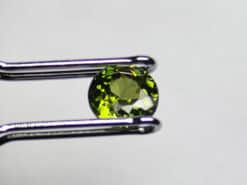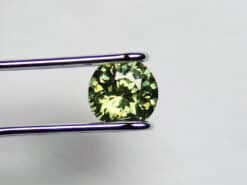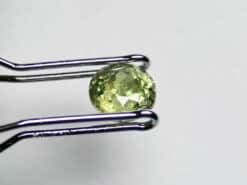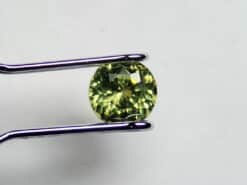Demantoid

Demantoid is the green gemstone variety of the mineral andradite, a member of the garnet group of minerals.
Buy natural demantoid in our shop
Demantoid garnet meaning
Andradite is a calcium- and iron-rich garnet. The chemical formula is Ca3Fe2(SiO4)3 with chromium substitution as the cause of the green color. Ferric iron is the cause of the yellow in the stone.
It has the misnomers olivine, and Uralian emerald.
In approximately 2003, reports began to circulate in the trade that some Russian demantoid garnets were being routinely subjected to heat treatment in order to enhance their color. Such treatment is believed to be performed at relatively low temperatures and is thought not to be detectable by gemological testing.
The green variety of andradite garnet
Demantoid is the green variety of andradite garnet, so the stones are always primarily green (by definition), but the exact shade ranges from a very strong yellowish green to nearly the color of a fine emerald. Some stones have a brownish cast, which is due to iron.
Its dispersion (0.057) is unusually high, and this is often visible as “fire” (rainbow-coloured flashes of light), although in some cases the stone’s green body colour can render this effect less noticeable. Their luster is adamantine. The stone also has a high refractive index of 1.80 to 1.89.
The gemstones are generally small, with finished stones generally under 1 carat (200 mg) and stones over 2 carats (400 mg) are rare. Stones over 3 carats (600 mg) are very rare.
Stones with more intense green coloration are generally highly valued, but lighter stones of yellowish green display substantially more fire. The choice of stone color or fire can therefore be a matter of personal preference, with some preferring the more yellowish-green stones to the green stones.
Horsetails
Russian demantoid often contain inclusions of chrysotile, which is a type of asbestos. These fibers radiate out from a very small crystal of chromite. These inclusions are feathery golden threads that tend to curve and resemble the tail of a horse, and are therefore referred to as horsetail inclusions.
In gemology, the presence of such inclusions is regarded as ‘diagnostic’ for natural gem (i.e. these inclusions are not found in any other green gemstone).
Some gemstones are more valuable for their inclusions, and ‘horsetails’ can be regarded as desirable features in crystal, as they are taken as an indication of prestigious Russian origin, although some gemstones from certain other locations (such as Italy and Iran) may also contain ‘horsetails’, which are regarded as being characteristic of a serpentinite geographic origin, and, on the other hand, not all Russian stones actually contain ‘horsetails’.
the stone is the green gemstone variety of the mineral andradite, a member of the garnet group of minerals. The microstructure of some stones is believed to be affected by the presence of ‘horsetails’ (the ‘horsetail’ typically originates towards the centre of the nodule, with the fibres branching out and radiating towards the surface), whereas horsetail-free crystals from other sources frequently display flat crystal faces.
Demantoid meaning and properties
The following section is pseudo scientific and based on cultural beliefs.
Physically, The stone t helps with eyesight, blocked arteries, the immune system, and the respiratory system (especially illnesses such as bronchitis and pneumonia). Like other Garnets, it can be used to improve bone marrow, alleviate arthritis and rheumatism, and assimilate Vitamin A.t
Sample from Namibia
FAQ
Is demantoid garnet valuable?
Even with the discovery of new sources since the 1990s, the stone remains very rare. It’s the most well-known andradite garnet and one of the most valuable garnets of any variety. Clean, facetable stones command very high prices per carat.
Where does demantoid garnet come from?
The stone was first discovered in the Ural Mountains in Russia in 1853; the Russian deposits remained the only source until a major find was discovered in Namibia (the Green Dragon Mine) in 1996. In 2003, there was another significant deposit discovered in Madagascar.
What is the difference between demantoid and tsavorite garnet?
The garnets have a very high refractive index and dispersion level, which is higher than a diamond. Tsavorite garnet is fashioned like many colored stones. Tsavorite will display white and green light back to your eye. You will not see the intensity of fire.
Where is demantoid found?
The stone has been found in Italy and Iran, and more recently Namibia (1996). However, the Russian material continues to be the standard by which the gem is judged.
















